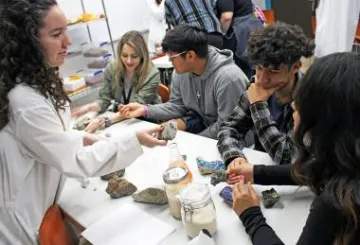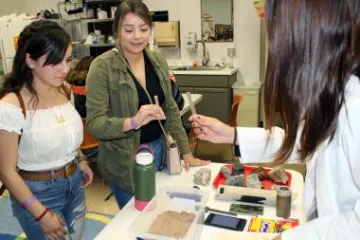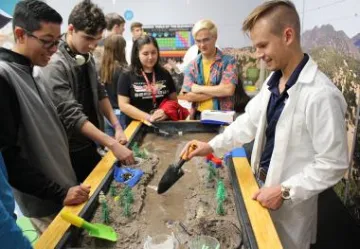
Students examine different types of ore
Sharing the importance of mineral resources with the next generation
In the fall of 2019, the Lowell Institute for Mineral Resources teamed up with The University of Arizona’s Flandrau Planetarium and Science Center to launch The Mineral Resource Discovery Workshop.
The workshop shows students how science, engineering, and technology are used in mines to extract the resources necessary for society while keeping the environment safe. In its inaugural year the workshop was attended by nearly 500 students aged 8 to 18 from schools located all over Tucson.
The workshop is part of Flandrau’s “Discovery” series aimed at helping K-12 students understand how to think like scientists while introducing them to a variety of science fields through interactions with university students. The Discovery series has another objective: preparing future STEM educators; UA students enrolled in STEM fields teach the workshop.
"Seeing the faces of students, from all walks of life, light up with a smile when you teach them how copper is found or how some green ore can turn into a rustic red metal is one of the most rewarding feelings you can experience.” – John Gengler, Geosciences undergraduate and workshop instructor
So, what do students learn?

The workshop focuses on copper since it is the mineral resource Arizona is most famous for, and even kindergarteners learn that it is one of the “5 C’s of Arizona”. As one teacher confirms: “Mining copper is important to Arizona and relevant to students.” Over the course of 2 hours, groups of no more than 5 participants rotate among the five stations that cover the life cycle of a mine beginning with ore formation through the actual extraction all the way to environmental reclamation. All stations are fully hands-on and use simple analogies to real-world processes.
Chronologically first comes Ore Formation. Why does copper occur in certain locations and not others, and why can’t we mine anywhere we choose? Students learn how geologic processes lead to copper ore formation. They explore how different rocks can have different concentrations of copper then learn about how the copper becomes concentrated in those rocks. An experiment visualizes how gasses in the magma chamber bring copper and other minerals to the surface: Gas bubbles produced by an Alka-Seltzer tablet carry red food dye from the surrounding water into and above a layer of oil sitting on top of the water. At the end of the experiment, a thin layer of red dye, which represents copper and other metals, forms atop the oil. Its visual and practical nature makes this station a favorite among students.
The second workshop station, Exploration, explains how geologists look for copper and other mineral resources. Students learn about mapping and then conduct a geomagnetic survey by using a small magnetometer attached to graphing software to find a target (a small magnet) buried in a box full of kinetic sand. The magnet represents the iron minerals often present near porphyry copper deposits. Once the target is located students drill into the magnetic sand near the target with large-diameter hollow straws to locate the ore body. Each student will then log the contents of their “drill core” consisting of kinetic sand and playdough (the ore body) on a worksheet. By using different colors students make a simple cross section showing where the ore is under the ground.
Once the ore body is located, mining proper can begin, but only the mine has been designed. At the third station, Mining, students can use actual mining design software to balance geologic models, human and environmental safety in planning a mine. Videos show mining equipment and practices.

Undergraduate Alejandro Durazo at the Environmental Reclamation station
Metallurgy, the fourth station, explains how ore is processed to recover and refine copper using chemistry. Students extract copper from copper oxide ore using a vinegar solution. Once they have a copper solution, students use a battery to take the copper out of solution and observe it plating onto a nickel. Students also learn about the flotation process by crushing sulfide ore and putting it in a demonstration flotation chamber. They can then observe how a reagent and air bubbles interact to bring the powdered sulfide to the top of the chamber.
The final station, Environmental Reclamation, shows how environmental scientists and engineers mitigate some of the environmental impacts of mining. In a large water table filled with sand and divided into two shorelines along a river, students must decide the best location for an unwanted rock pile taken out of a mine. They must consider the wildlife and plants that may be displaced by the rockpile, and the ways to contain and treat water runoff from the rock pile. Chris Earnest: “The station challenges students to find a solution that satisfies various stakeholders in situations where there is often no ‘perfect’ solution”. Once complete, their solution is tested with simulated “monsoons rains”. In the course of a quick and strong downpour as they are common in Arizona the students observe how well their plans hold up under adverse conditions.
After the students have completed the five station, they have experienced how science, technology and engineering concepts are used in a real-world setting and in applications that affect our lives.
A fun and meaningful experience for teachers, students, and student instructors
“Great basis for young minds” was how one teacher described the workshop. Visiting students enjoy the interaction with future scientists of different areas, who are described as “enthusiastic”, “engaging,” and “energetic” by accompanying teachers. So how do the student instructors feel about it?
“There was never a dull day of teaching children and young adults what I love to learn, geology of earth and Arizona. Each day was new and each one brought joy and a feeling of pride to my fellow student instructors and me." – John Gengler, Geosciences undergraduate and workshop instructor
To prepare, student instructors enroll in a for-credit class taught by the Lowell Institute’s education outreach coordinator, Chris Earnest, an experienced K-12 educator and UA Geosciences alumnus. Chris also helped develop the stations and oversees the workshops: “We had faculty and graduate students from all over the university, as well as industry professionals, helping us prepare the activity stations. People were excited and motivated to get involved.”
Many workshop visitors make a whole day of it, adding a visit to the Science Center, a planetarium show, and lunch on the mall for that on-campus experience.
To make the program more financially accessible, schools participating in the Title IV federal student aid programs pay a reduced workshop fee and can apply for a scholarship provided by Mining Foundation of the Southwest and the Lowell Institute for Mineral Resources to cover the workshop fee.

